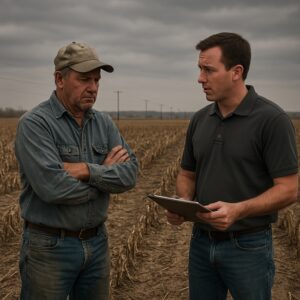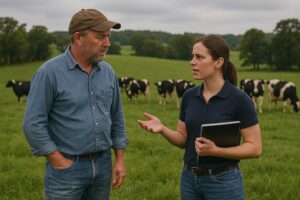One of my best customers used to have fun by frequently referring to me and my competition as “feed peddlers”. I think he was just having fun as he did continue to buy from me and we had a good working relationship as well as a friendship over the years. His insinuation that we were all out hawking goods on price.
In this week’s post, I want to address the “Price” issue that comes up in almost every buy: sell relationship. Especially for Ag Sales Professionals calling on farmers, livestock producers and Ag Retailers. Here’s why. By the very definition, we are in a commodity business. We buy and sell large quantities of a product that meet a minimum grade so that we can insure feed & food safety, assure fair trade and reduce fraud in the market. This creates the idea that corn is corn is corn and your 38% dairy pellet is the same as their 38% dairy pellet. So, this must mean it’s just down to price.
Reinforcing the commodity mindset is human nature. With thousands of ideas and pieces of information coming at us daily, customers are forced to make quick judgements and categorize (segment) information. With 6 or 7 feed sales people on his dairy farm, a dairy producer has to categorize them into a segment called “feed sales” and move on to the next 20 tasks on his list that day. With little time to evaluate, he will most likely use price to make his decision.
What to do? While the list below isn’t all inclusive, I hope you find value on some of the techniques that I have used through the years
- Segment: Segment your customers into “price” buyers, “moderate value” buyers and finally “value” buyers. With value buyers, it’s obvious what to do. They understand the value of what you bring to the market, how you are different than your competition and are willing to pay for it. Moderate value customers are those customers with one foot in each camp. They value and understand some of the aspects you bring to the market but either can’t or won’t pay without scrutiny. This leaves our last category: the price buyer. The old sales slogan implies that when you haven’t differentiated your product, it comes down to price. While very true, I think there is also a segment of customers in the Ag world that will just not pay for a higher value. There is also a segment of the Ag world that will only start doing business with you on the price sensitive products and then allow you into their value added purchases. They will buy some loads of finishing feed if you are competitive. Once they gain trust in your ability to deliver, the quality of your products and your pricing, only then can you gain access to the higher end or value added starter & breeder diets. Don’t be afraid to work your way in
- Create your value ladder of products: Many sales people launch into Ag sales with the mindset that they have the greatest product on the market and that every Ag producer should understand its value and buy it. So, to phrase it – They go out and try to sell Cadillacs to every car buyer. Unfortunately, they get frustrated as there are a lot of Chevy buyers out there and even a few AMC buyers for those of us that remember the Pacer and the Gremlin. You can spend a lifetime trying to convince people to move up the value chain on your products or you can have an array of products to fit those buyers. Let’s take dog food for example. There was a price point buyer for many years in the dog food market at $10/bag. In the end, they weren’t real worried about nutritional content nor the outcome of it. They wanted a cheap ($10) bag of dog food. It is worthy to ask key questions to see if this customer wants to move up the value ladder to a better and more digestible dog food. However, spending large amounts of energy on it will most likely lead to frustration and an annoyed customer. Offer the low end product, offer to educate on the higher end products you have, but ultimately, this buyer needs to arrive at their decision and live with the consequences of it.
- Figure out how you (as the sales person within your company) can create value. Sounds obvious and sounds easy, but how. First, understand your position in the market. Are you David or Goliath? If you are small (David), then you can use flexibility and maneuver around the competition. Look for those customers that maybe can’t afford or their systems won’t allow them to work with the large companies in your industry. Offer a differentiated product that fits them better. If you are selling for a large company(Goliath), understand that value and what you bring to the market: name brand recognition, in house research, a vast team of experts, more advanced marketing programs. Next, move into how you can create value in your territory. How? Differentiate yourself from your competition’s sales team by
- Create your brand. You are the brand. To your customer, you are the company. Sure the company matters but you represent that brand. So, understanding that it’s more than logos and slogans is critical to owning your brand in your territory. Be the person they want to buy from.
- Do what you say you will. Follow up. Be organized enough so you can follow up. Don’t drop the ball. If you do, fix it and don’t do it again (at least not with this customer) – earning trust.
- Creating value with your delivery team. Many times, your customers will talk to your delivery drivers and your order entry team more than they talk with you. Make them part of your go-to-market team. They are a vital part of your offering in the market and help you differentiate. I could go on for hours on how they helped and how they hindered sales over the years. One quick driver story. Customer ordered or the order entry team put in the wrong feed order. Driver loaded it at the mill, went to deliver it and realized it wasn’t the right feed for that bulk bin. Major error averted and loss of production in that dairy herd prevented because a driver spoke up. If your service team isn’t up to what you feel it needs to be, start today with a small discussion on how it could be improved. I recommend starting very gradual and definitely seek to understand as many times there’s a need to vent frustrations first, then figure out ways to improve.
A lot of emotional energy is spent by sales teams that get frustrated with customers who won’t see the value of their products. The strategies above have helped the teams I’ve worked with in alleviating some of that stress. Just understanding that this is part of the sales process and that customers will evolve through it over time is enough to reduce much of that stress. Understanding that you have the ability to differentiate at your territory level gives you the confidence to deal with any price-to-value level customer you come across.
For more on Ag Sales Training, Ag Sales Coaching and Leading Ag Sales Teams, go to
http://www.GregMartinelli.net/
To discuss sales training or presentations for your team, contact me directly at Greg@GregMartinelli.net



